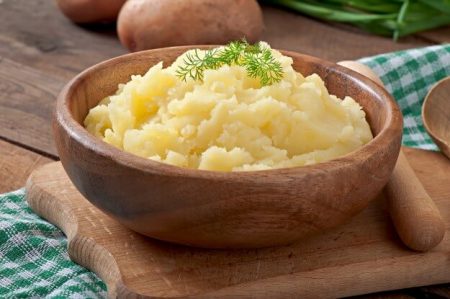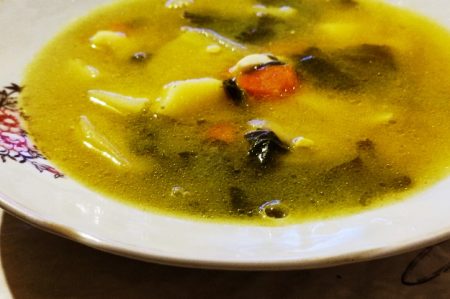The recipe for Red Ukrainian Borsch with Flour comes from an old Ukrainian cookbook, “Ukrainian-English Cook,” published in 1917 in Edmonton, Alberta. Rediscovered by the Ukrainian diaspora in Canada, this cookbook contains forgotten authentic recipes that reflect traditional Ukrainian flavors.
The original recipe calls for using pottery and slow baking in the oven to enhance the taste. While modern methods may differ, slight adjustments can be made while still honoring the original process. The flour adds a unique richness to the borscht.
Recreate this dish by following the traditional ingredients and techniques, making small updates as needed. Each spoonful of this borscht brings the taste of Ukrainian history to the present day.
Directions
0/0 steps madeCut the beets into strips. Pour 2 liters of cold water and cook in a saucepan.
- Chop the onion and parsley and add them to the saucepan. Leave to simmer for 1.5 hours over low heat.
- Separately, in another saucepan, cook pork or beef in 1 liter of water. Cook over low heat for 1.5 hours.
- Add salt to the bowl in which the beets are cooked. Pour the contents of a saucepan of beets into a saucepan of meat. Pour carefully so as not to burn yourself with the boiling water. Or let the boiling water cool slightly.
- Put a tablespoon of sugar in the borsch.
- Take thick sour cream and put a tablespoon of flour in it. Mix well.
- Pour the mixture into the borsch slowly, stirring occasionally.
- Serve with herbs.
As you can see, the dish turns out to be very high in calories. You have to consider this.
Who, why, and when cooked Ukrainian borsch first in the world?
The exact origins of borscht are uncertain, but it is generally believed to have originated in Eastern Europe, with Ukraine being one of the countries that claim it as their own.
Borscht has been a staple in Ukrainian cuisine for centuries, and it is a beloved dish that is often associated with Ukrainian culture.
There are many variations of borscht, and each region and family has its unique recipe. The traditional Ukrainian borsch is made with beets, cabbage, potatoes, onions, and sometimes meat or beans, and it is typically served with sour cream and fresh dill.
It is unclear who exactly cooked the first pot of borscht, as it has likely been prepared in various forms and by different people throughout history. However, Ukrainian borsch has been a part of Eastern European cuisine for centuries and has been enjoyed by people in Ukraine and other countries for generations.
How Old Ukrainians Cooked the Borsch
Historically, Ukrainians cooked borscht using simple, locally available ingredients, with the recipe varying by region and season. The base of the soup was usually made with beets, which gave borscht its distinct deep red color, along with vegetables like cabbage, carrots, and onions.
Meat, typically pork or beef, was added to enrich the broth, and the soup was flavored with garlic, dill, and sometimes a touch of vinegar or sour cream to balance the flavors.
In traditional Ukrainian households, the cooking process was often slow and meticulous. Pottery or cast-iron pots were used to simmer the borscht for several hours, allowing the flavors to meld together.
Once prepared, borscht was often served with a slice of homemade rye bread and a dollop of sour cream. It was a versatile dish, eaten hot during the colder months and often chilled during the warmer seasons.
This humble but nourishing meal has been passed down through generations, remaining an iconic part of Ukrainian cuisine.
Source of the video TSN.ua
Why is Red Ukrainian Borsch Good for Health?
Ukrainian red borscht is a flavorful and nutrient-rich soup made with vegetables like beets, cabbage, and carrots. This traditional dish not only tastes great but also supports a balanced, healthy diet.
The vegetables in red borscht provide essential nutrients. Beets are especially beneficial, offering fiber, folate, manganese, and potassium.
Thanks to its high fiber content, borscht helps maintain a healthy digestive system and may reduce the risk of constipation. Traditional red borscht is naturally low in fat, especially when made without added oils or fatty meat. This makes it a smart choice for those watching their fat intake.
Add kidney beans to increase the soup’s protein content. It’s a great way to make borscht more filling and muscle-friendly. Beets, the star ingredient, are also loaded with antioxidants. These compounds help protect your body from oxidative stress and inflammation.
About Borsch and UNESCO
In 2015, UNESCO officially recognized borscht as part of the Intangible Cultural Heritage of Humanity. This acknowledgment highlights the deep cultural importance of borscht in Eastern European culinary traditions.
The inclusion of borscht on this prestigious list helps preserve its historical value and ensures that future generations will continue to celebrate and cook this iconic dish. It also emphasizes how traditional foods like borscht reflect the rich identity and diversity of the region.
By protecting borscht as cultural heritage, UNESCO draws attention to the role of national cuisine in maintaining cultural roots and expressing shared identity through food.





Recent comments